- Share full article
Advertisement
Supported by

Crash Near Finish Throws Tour de France Into Chaos

By Ian Austen
- July 14, 2016
VAISON-LA-ROMAINE, France — His bike crushed under a motorcycle’s tires, his Tour de France lead in jeopardy and his rivals pedaling away, Chris Froome did the only thing he could think to do: He ran toward the finish line.
It was a stunning moment in a modern Tour de France: The holder of the race leader’s yellow jersey suddenly turning into a runner, heading up a mountain pass without his bike.
It took an appeal to prevent Froome, a Briton with Team Sky, from losing the race lead.
. @ChrisFroome à pieds dans le final de l'étape / @ChrisFroome is running in le Ventoux 💪 #TDF2016 https://t.co/o3fgyrRRST — Tour de France™ (@LeTour) July 14, 2016
The chaotic string of events began on Thursday when spectators swarmed over the road about one kilometer from the finish of Stage 12’s truncated climb up Mont Ventoux. They forced a television motorbike to stop suddenly at the same time that Richie Porte, an Australian with the American BMC team, attacked Froome. Some reports said the motorcycle hit a spectator who was blocking the road.
Porte smashed face-first into transmission equipment on the back of the motorbike. Bauke Mollema, who was also with Porte and Froome, cartwheeled into the air. Froome hit the ground on the other side of the motorcycle, out of its camera’s sight, with Mollema ending up on top of him.
Adding to the confusion, a large police motorcycle then ran over Froome’s Pinarello bicycle, breaking it. Immediately on the scene were mechanics who provide service to riders when their team cars are not nearby. But they were traveling by motorcycle and had only spare wheels to offer.
That’s when Froome changed sports. Uncertain about when a team car might arrive with his spare bike, he propped his broken machine against a photographer’s motorcycle and began running.
For about 40 agonizing seconds, he chugged along at a remarkably good pace, considering he was wearing shoes with rigid carbon fiber soles and heading up a steep mountain road.
Porte, after fiddling with his bike, remounted it and wobbled past Froome, who kept looking backward for salvation.
Another group of neutral service mechanics appeared in their yellow station wagon and gave Froome one of the rarely used generic bicycles from its roof. It was too small for Froome. Even worse, he was unable to clip into its pedals, which were not compatible with shoe cleats.
One of Froome’s team cars finally arrived, and he changed bikes again.
By the time he crossed the line, Froome had lost the yellow jersey, on paper at least, to another British rider, Adam Yates, of the Orica-BikeExchange team. Froome, realizing that was the case, shook his head when he crossed the line.
Cycling’s rule book includes a section that prevents riders from incurring a time penalty if they crash or have a mechanical problem within the final three kilometers of a stage , provided that they eventually make it across the finish line.
But that does not apply to mountain stages like the one on Thursday.
Froome’s team appealed to the race referees, who represent the International Cycling Union, the sport’s governing body, not the Tour organization. They agreed that the unusual circumstance warranted a time adjustment for Froome.
“What a finish; Ventoux is full of surprises,” Froome told France Télévisions as he thanked the jury of referees and the race organization. “I’m very content.”
Yates, if anything, appeared relieved.
“You don’t want to take the yellow jersey like that; you want to take it with your legs,” he said. “He’s the rightful holder of the yellow jersey.”
The incident is likely to increase growing concern among riders about the dangers posed by the 70 motorbikes within the race and the behavior of some fans, many of them apparently less than sober.
Even after the crash, a man with a handwritten sign supporting the Polish climber Rafal Majka repeatedly blocked a television motorbike as it tried to follow Froome’s run.
“If you can’t control the crowds, what can you control?” Porte said. “It’s not really the motorbikes, it’s the crowd. They’re just in your face the whole time, pushing riders, and at the top there, that was just crazy.”
On most days at the Tour, at least in the final kilometer, crowd barriers line the road to the finish line and the police deal severely with fans who try to circumvent them.
That was not the case on Thursday because of a decision made the previous night, paradoxically, in the interests of safety. The finish line was moved six kilometers down Mont Ventoux to avoid fearsome winds that were blowing down recreational riders at its rock-strewn summit. On Thursday, the winds flipped over a tourist’s camping trailer near the top.
Christian Prudhomme, the Tour’s director, said wind problems at the revised finish line, on a road in a forested area, prevented crews from putting up the normal number of barriers. He did not offer any apology to the riders when speaking to reporters.
While the failure to control the crowd had an obvious cause, motorcycles are a more thorny issue. Some riders have proposed that they be replaced by scooters. But that idea has gone only as far as a single mechanical service scooter.
It seems unlikely, however, that scooters could carry the equipment needed for live television transmission or provide adequate speed for the gendarmes who patrol the race route.
Almost lost in all the confusion was the day’s racing. For the first time in this Tour, Nairo Quintana, a Colombian with Movistar, who is seen as a top challenger, attacked Froome on the Ventoux climb.
But he was unable to cause any grief for Froome, who left Quintana behind in the closing moments of the stage. But up to the point of the crash, Froome had been unable to shake Porte, who previously rode for Sky and was Froome’s key assistant in the mountains.
Ahead of the chaos and the impromptu running competition, the stage was won by Thomas De Gendt, a Belgian with Lotto Soudal, who outdistanced another Belgian, Serge Pauwels, of the Dimension Data team. Afterward, they said that they struggled to make it through the crowd that set off the chain reaction that brought down Froome, Porte and Mollema. Neither De Gendt nor Pauwels is a likely threat to win the overall title.
On Friday, the riders will contest the Tour’s first time trial, in which they individually race against the clock. The event is one of Froome’s specialties.
Cycling Around the Globe
The cycling world can be intimidating. but with the right mind-set and gear you can make the most of human-powered transportation..
Are you new to urban biking? These tips will help you make sure you are ready to get on the saddle .
Whether you’re mountain biking down a forested path or hitting the local rail trail, you’ll need the right gear . Wirecutter has plenty of recommendations , from which bike to buy to the best bike locks .
Do you get nervous at the thought of cycling in the city? Here are some ways to get comfortable with traffic .
Learn how to store your bike properly and give it the maintenance it needs in the colder weather.
Not ready for mountain biking just yet? Try gravel biking instead . Here are five places in the United States to explore on two wheels.
Chris Froome wins 2016 Tour de France as André Greipel takes final stage
Chris Froome takes his third Tour de France victory in Paris on Sunday as André Greipel takes the final sprint showdown on the Champs Élysées
- Sign up to our newsletter Newsletter
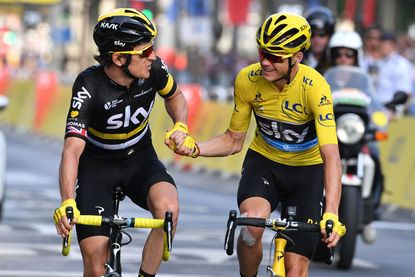
Chris Froome and Geraint Thomas on stage 21 of the 2016 Tour de France
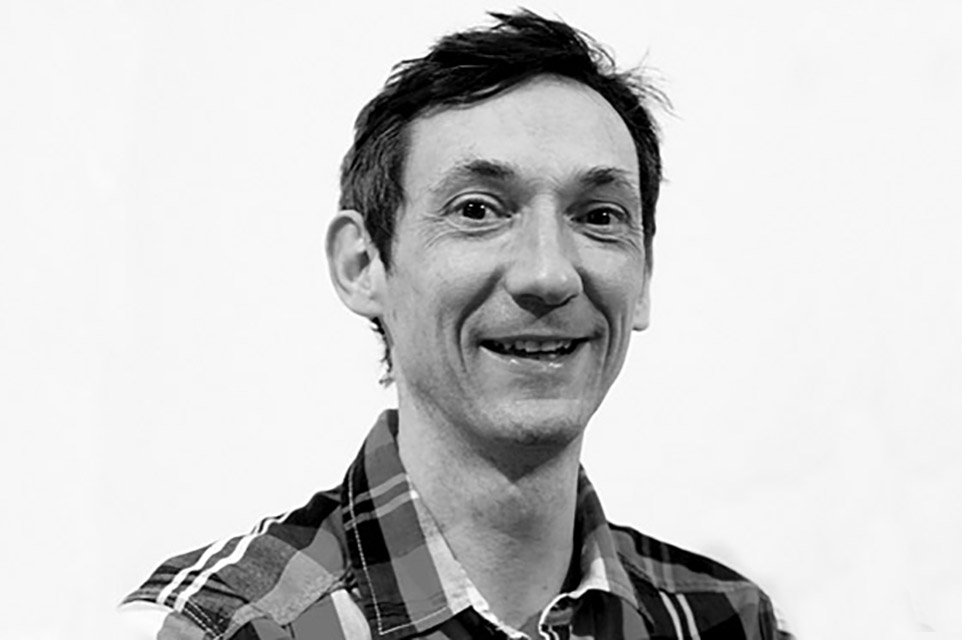
Chris Froome (Team Sky) elevated himself further among the cycling greats by winning the 2016 Tour de France in Paris on Sunday, his third Tour victory.
Froome took the lead after winning stage eight of the 103rd edition of the race and never looked back. He survived running up Mont Ventoux and crashing in the Alps to secure the historic victory.
Froome finished the race four minutes and five seconds ahead of Frenchman Romain Bardet (Ag2r La Mondiale), with Nairo Quintana (Movistar) in third at 4-21.
Along with Froome's overall win and two stage wins, plus four stage wins for Mark Cavendish (Dimension Data) and one for Steve Cummings (Dimension Data), British success continued with Adam Yates (Orica-BikeExchange) securing the white jersey of best young rider and placing fourth overall. It's the first time a British rider has ever topped the best young rider classification and has now set him up as an exciting new Grand Tour prospect.

German sprinter André Greipel (Lotto-Soudal) won the bunch sprint at the end of the final stage, out-pacing points classification winner Peter Sagan (Tinkoff) to the line. Alexander Kristoff (Katusha) was third. British sprinter Dan McLay was 12th, having completed his first Tour.
It's Greipel's sole stage victory in the 2016 race, and is his 11th Grand Tour since 2008 with at least one stage victory.

Before the frantic finale, the traditional procession after the start of the last stage saw a slow pace as riders chatted and got to enjoy rolling along in the warm, sunny weather. Froome and Sky team-mates indulged in an unconventional bottle of beer followed by a more conventional glass of Champagne.
Get The Leadout Newsletter
The latest race content, interviews, features, reviews and expert buying guides, direct to your inbox!
It wasn't until the race hit the Champs Élysées that the pace picked up and a break formed with 50km to go.
Jan Barta (Bora), Marcus Burghardt (BMC), Rui Costa (Lampre-Merida), Lawson Craddock (Cannondale-Drapac), Brice Feillu (Fortuneo-Vital Concept), Alexis Gougeard (Ag2r-La Mondiale), Jérémy Roy (FDJ) and Daniel Teklehaimanot (Dimension Data) were the eight riders to finally get away.
Marcel Kittel (Etixx-QuickStep) suffered a technical mishap, and was seen throwing his rear wheel across the road after a couple of bike changes. He then paced himself back up to the bunch without the help of team-mates, but the effort would see him out of the running in the final sprint.
The break was joined by Sky duo Luke Rowe and Wout Poels, who bridged over with 18km to go evidently trying to get rid of any unexpended energy from the previous three weeks.
>>> Chris Froome and Peter Sagan’s special bikes for Tour de France final stage
All escapees were caught with 10km to go, and the bunch was still all together with one lap of the cobbled loop and 6.6km to go. It took a while for the sprinters' teams to get organised at the front, with a jumble of riders initially jostling for position.

A couple of late crashes took out a few riders, and French sprinter Bryan Coquard (Direct Energie) appeared to suffer from a puncture with 3km to go, his hope of a stage win over.
The tight corners into the finish straight disrupted Greipel's Lotto-Soudal sprint train, but he jumped on Kristoff's rear wheel and accelerated away on the cobbles. Sagan was gaining on him as Kristoff faded, but Greipel lunged clear on the line to win on the Champs Élysées for a second consecutive year.
Tony Martin (Etixx-QuickStep) was a surprise abandon during the final stage after suffering from knee pain during the stage. It left 174 riders left in the race, the highest ever number of finishers in the race's 103 editions – the previous record was 170 in 2010.
>>> Tour de France 2016: Latest news, reports and info
Tour de France 2016, stage 21: Chantilly to Paris Champs-Élysées, 113km
1. André Greipel (Ger) Lotto-Soudal in 2-43-08
2. Peter Sagan (Svk) Tinkoff
3. Alexander Kristoff (Nor) Katusha
4. Edvald Boasson Hagen (Nor) Dimension Data
5. Michael Matthews (Aus) Orica-BikeExchange
6. Jasper Stuyven (Bel) Trek-Segafredo
7. Ramunas Navardauskas (Ltu) Cannondale-Drapac
8. Christophe Laporte (Fra) Cofidis
9. Sam Bennett (Irl) Bora-Argon 18
10. Janse Van Rensburg (RSA) Dimension Data all same time
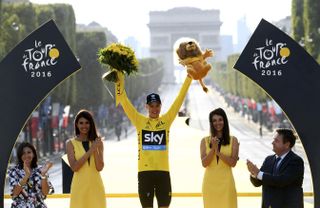
Final general classification
1. Chris Froome (GBr) Team Sky in 89-06-01
2. Romain Bardet (Fra) Ag2r La Mondiale, at 4-05
3. Nairo Quintana (Col) Movistar at 4-21
4. Adam Yates (GBr) Orica-BikeExchange at 4-42
5. Richie Porte (Aus) BMC at 5-17
6. Alejandro Valverde (Esp) Movistar at 6-16
7. Joaquim Rodriguez (Esp) Katusha at 6-58
8. Louis Meintjes (RSA) Lampre-Merida at 6-58
9. Dan Martin (Irl) Etixx-Quick Step at 7-04
10. Roman Kreuziger (Cze) Tinkoff at 7-11

King of the Mountains classification: Rafal Majka (Pol) Tinkoff
Points classification: Peter Sagan (Svk) Tinkoff
Young rider classification: Adam Yates (GBr) Orica-BikeExchange
Best team: Movistar
Thank you for reading 20 articles this month* Join now for unlimited access
Enjoy your first month for just £1 / $1 / €1
*Read 5 free articles per month without a subscription
Join now for unlimited access
Try first month for just £1 / $1 / €1
Nigel Wynn worked as associate editor on CyclingWeekly.com, he worked almost single-handedly on the Cycling Weekly website in its early days. His passion for cycling, his writing and his creativity, as well as his hard work and dedication, were the original driving force behind the website’s success. Without him, CyclingWeekly.com would certainly not exist on the size and scale that it enjoys today. Nigel sadly passed away , following a brave battle with a cancer-related illness, in 2018. He was a highly valued colleague, and more importantly, an exceptional person to work with - his presence is sorely missed.
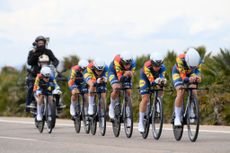
Gaia Realini takes an early lead over her rivals in the general classification
By Joseph Lycett Published 28 April 24
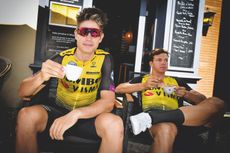
Coffee connoisseur Adam Becket delves into the storied yet mysterious relationship between cycling and the original energy drink
By Adam Becket Published 28 April 24

All the teams and riders for the 107th Giro d'Italia
By Adam Becket Published 25 April 24
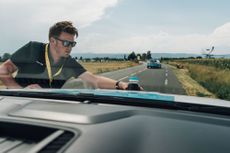
New Tour of Britain race director says he is still on good terms with Dave Brailsford after resigning from team last year
By Tom Thewlis Published 17 April 24
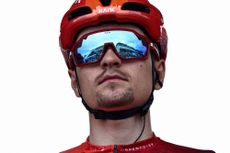
British rider was a late addition to the Ineos Grenadiers team for the race across the pavé
By Tom Thewlis Published 7 April 24
The Welshman also calls for better governance in the sport to help it grow further
By Chris Marshall-Bell Published 21 March 24
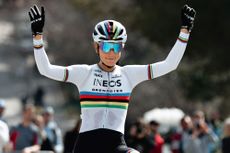
The British squad is one of the richest in cycling - but Ineos still won’t stump up for a women’s team
By Adam Becket Published 19 March 24

Pauline Ferrand-Prévot took the 500th team win at the weekend
By Tom Thewlis Published 18 March 24
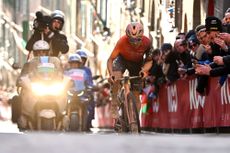
British rider will lead the line for Ineos Grenadiers alongside Filippo Ganna
By Tom Thewlis Published 14 March 24
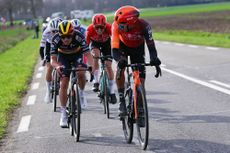
Colombian snapped up key bonus seconds in the general classification battle on run in to Les Mureaux
By Tom Thewlis Published 3 March 24
Useful links
- Tour de France
- Giro d'Italia
- Vuelta a España
Buyer's Guides
- Best road bikes
- Best gravel bikes
- Best smart turbo trainers
- Best cycling computers
- Editor's Choice
- Bike Reviews
- Component Reviews
- Clothing Reviews
- Contact Future's experts
- Terms and conditions
- Privacy policy
- Cookies policy
- Advertise with us
Cycling Weekly is part of Future plc, an international media group and leading digital publisher. Visit our corporate site . © Future Publishing Limited Quay House, The Ambury, Bath BA1 1UA. All rights reserved. England and Wales company registration number 2008885.
Expert road bike reviews and the latest road bike news, features and advice. Find rides & events, training articles and participate in our forums
Tour de france 2016: chris froome keeps yellow jersey despite crash on chaotic ventoux stage, team sky man runs up mont ventoux as roadside fans cause moto crash; thomas de gendt wins stage 12.
Chris Froome remains the leader of the 2016 Tour de France after a commissaire ruling, despite having to run part the way up Mont Ventoux after a crash involving a TV moto and roadside fans.
Thomas de Gendt (Lotto-Soudal) won stage 12 of the Tour de France at Chalet Reynard, the shortened finish of the Mont Ventoux stage, but the race was marred by the incident further back.
As race leader Chris Froome (Team Sky) accelerated away from the GC group with Richie Porte (BMC Racing) and Bauke Mollema (Trek-Segafredo) for company, the TV moto collided with roadside fans and took the three men out.
The incident left Froome and Porte without bikes, and saw the Team Sky man finish a couple of minutes down on his rivals and desperate for intervention by the race commisaires to retain his overall lead.
Luckily for Froome, however, they did just that – leaving him 47 seconds clear of second-placed Adam Yates (Orica-BikeExchange) overall.
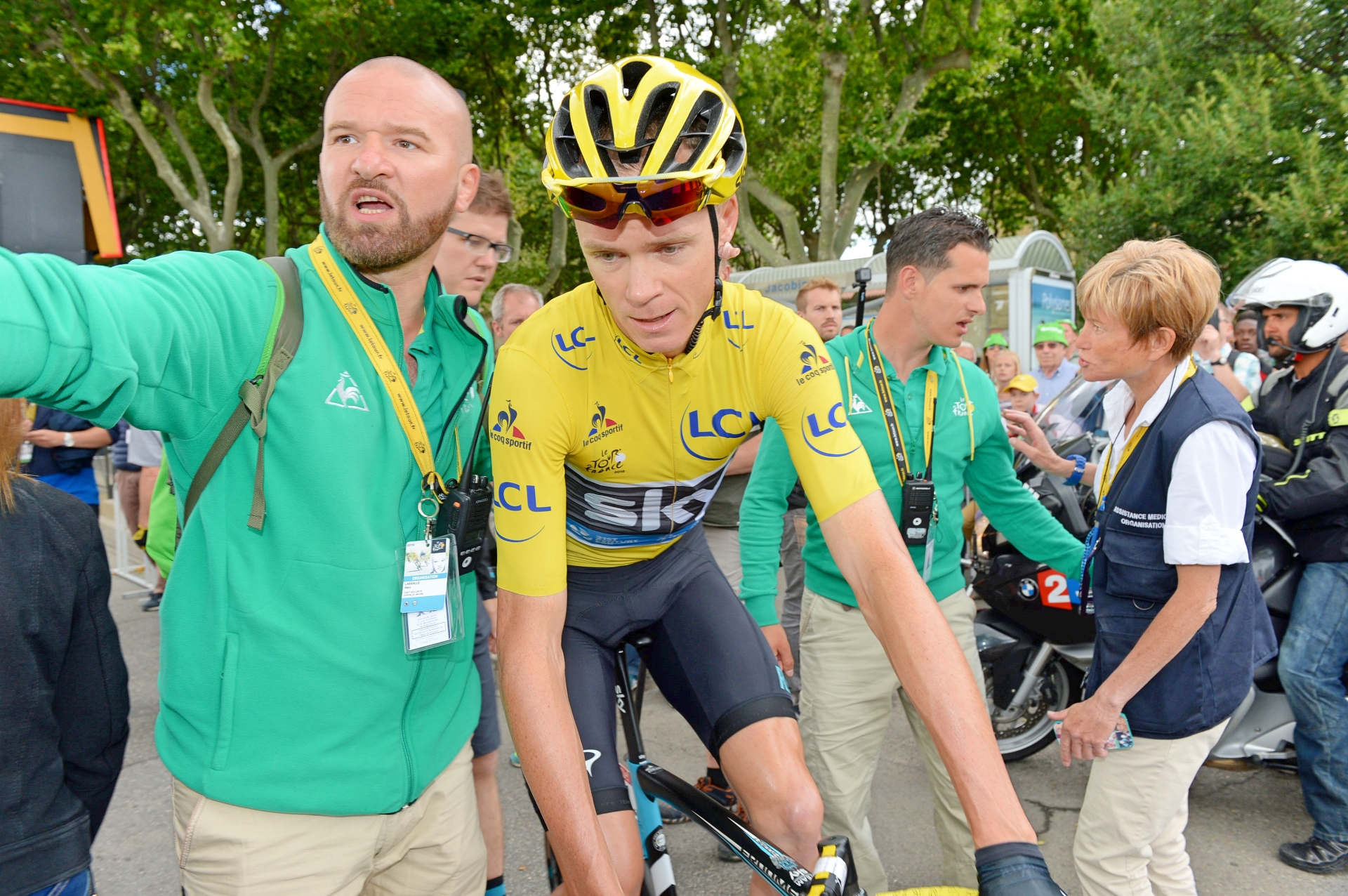
As is typical of Bastille Day, there was no shortage of French teams looking to get in the large day’s break.
Bryan Coquard and Sylvan Chavanel (Direct Energie) both made the split, as did Cyril Lemoine for Cofidis, alongside Spanish team-mate Daniel Navarro, while Fortuneo-Vital Concept were represented by Chris Anke Sorensen.
No FDJ riders made the split, but Iljo Keisse (Etixx-QuickStep), Thomas de Gendt and Andre Greipel (Lotto-Soudal), Serge Pauwels and Daniel Teklehaimanot (Dimension Data), Sep Vanmarcke and Bert-Jan Lindeman (Team LottoNL-Jumbo) and Stef Clement (IAM Cycling) were all there.
The large move was given plenty of leeway to attack – the gap going up to more than 18 minutes at its peak as the peloton kept plenty in reserve for the climb to Chalet Reynard.
A five-man counter-attack chased behind, with Diego Rosa (Astana) the most notable rider in the group, but they found themselves in no-man’s land for much of the stage.
High winds, and the ramping up of the pace in the peloton – Tony Martin (Etixx-QuickStep) in particular helping to cut the deficit to eight minutes on the Col des Trois Termes – also saw the bunch thinned out.
Thibaut Pinot (FDJ), in the polka dot jersey, was among those spat out the back alongside green jersey Peter Sagan (Tinkoff) and Louis Meintjes (Lampre-Merida), Warren Barguil (Giant-Alpecin) and Wilco Kelderman (LottoNL-Jumbo) – whose white jersey hopes are all fading fast.
Vincenzo Nibali (Astana) and Rafal Majka (Tinkoff) were also among those caught out, with the former’s absence almost proving costly for team leader Fabio Aru when he suffered an ill-timed mechanical.
Having initially taken a team-mate’s bike, Aru then swapped bikes just as the pace in the peloton was ramped up, and is likely to have to explain a couple of ‘sticky bottles’ and the drafting of the Astana team car to the race commissaires as he chased back on.
The wind caused havoc at the front of the massively reduced bunch too, with Simon Gerrans (Orica-BikeExchange) – leading the peloton at the time – sliding out on a blustery corner and taking Team Sky riders Luke Rowe and Ian Stannard with him, with several other Sky riders held up.
Yellow jersey Chris Froome took the absence of his team-mates as a chance to answer a call of nature and chase back on with them – Nairo Quintana’s Movistar coming to the front of the bunch and, as per the spirit of the peloton, refusing to kick on until the maillot jaune was back.
The slowing of the pace increased the gap to the breakaway, just as it looked to be rapidly coming down, and allowed a lot of those off the back – including the three young riders, but not Pinot – to rejoin the peloton.
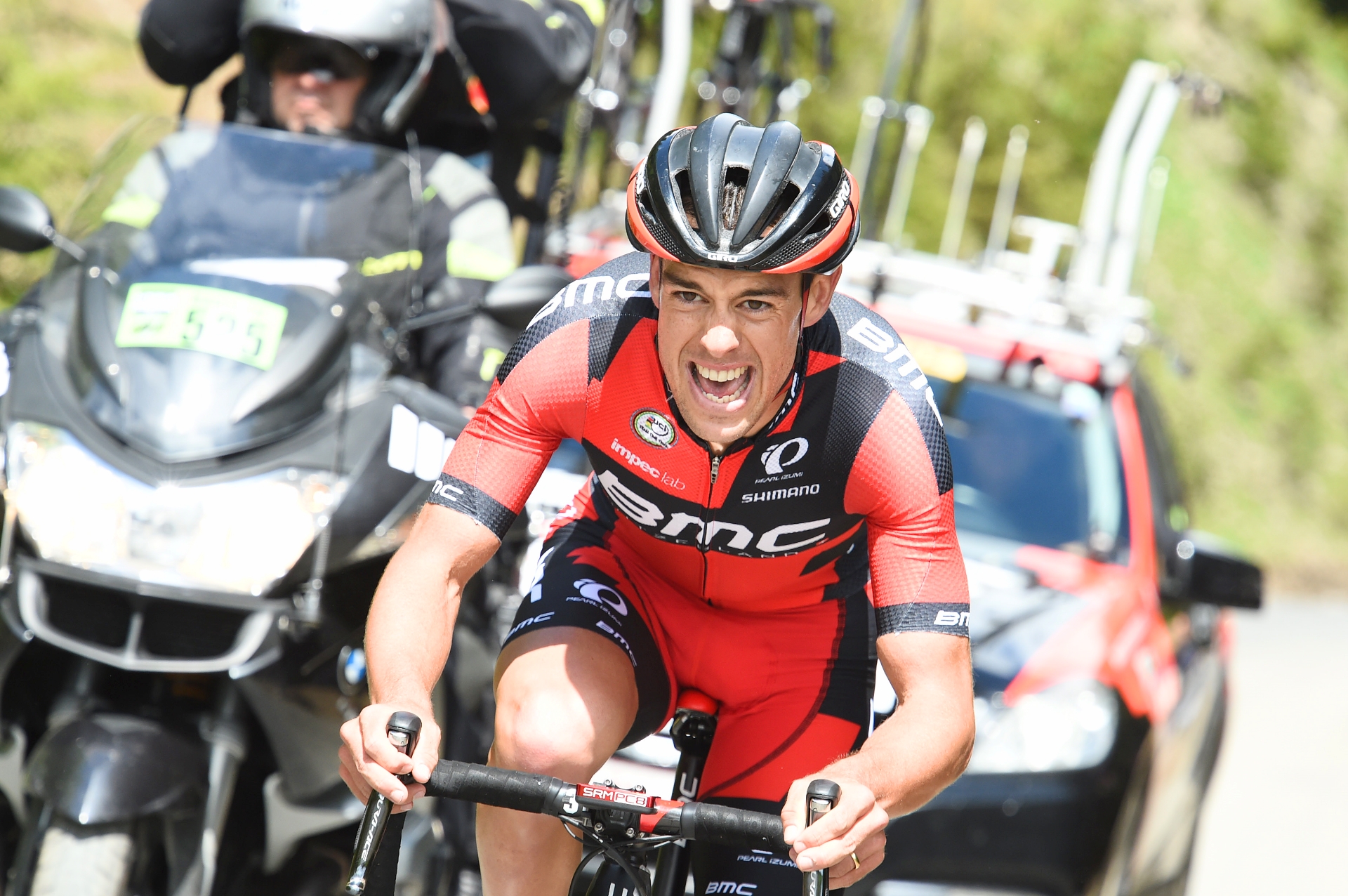
Greipel was the first man in the breakaway to try a solo effort, with the road kicking up from Bedoin before the real climbing started.
When the climbing did start, it didn’t take long for the break to fall apart – the three chief climbers in the group, namely De Gendt, Pauwels and Navarro – quickly distancing their companions.
In the peloton, Pierre Rolland briefly attacked off the front with Team Sky setting a pace which quickly shed plenty of riders just behind.
Up front, Chavanel managed to get back to the front trio, but another acceleration by Pauwels allowed him and Navarro to push on.
Jarlinson Pantano (IAM Cycling) and Alejandro Valverde (Movistar) were next to attack, with the latter’s move a foil for Nairo Quintana to kick on but Team Sky responded well, with Wout Poels closing the gap.
That flurry of activity obliterated the peloton again, with Dan Martin (Etixx-QuickStep), who started the day third overall, dropped from the GC group, as was Roman Kreuziger (Tinkoff).
At the front De Gendt came back strong to rejoin the front group, and attacked with 3.5km remaining – earning a gap that Pauwels and Navarro struggled to close.
Poels and Sergio Henao continued to lead the small GC group more than six minutes down the road, meanwhile, with Froome, Quintana and Valverde lined out behind.
BMC Racing duo Tejay van Garderen and Porte were also present, alongside Joaquim Rodriguez (Katusha), who was next to accelerate.
Romain Bardet (Ag2r-La Mondiale), white jersey Adam Yates (Orica-BikeExchange), Louis Meintjes (Lampre-Merida), Fabio Aru (Astana) and Mollema were all sat in the wheels meanwhile.
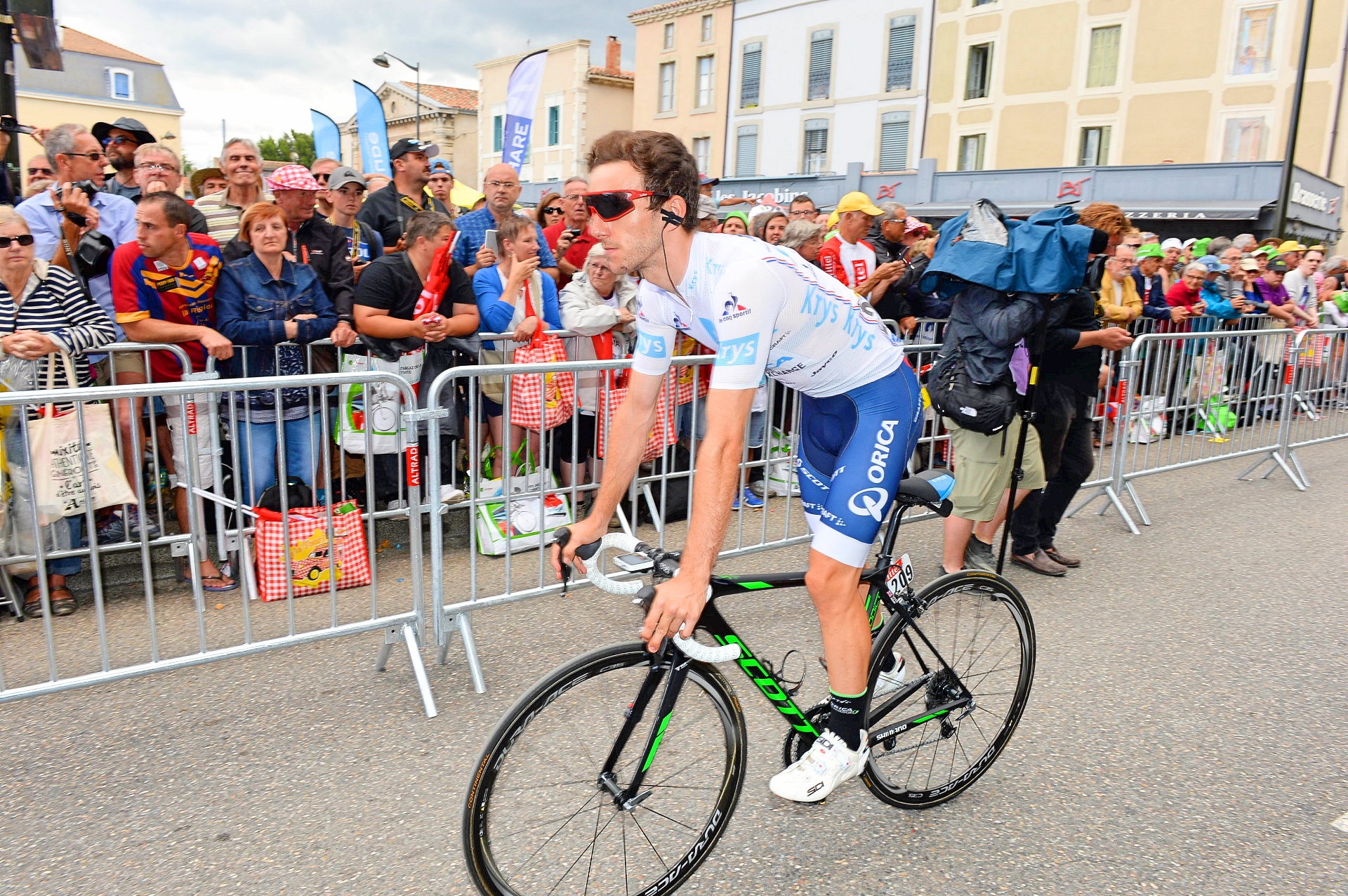
As the GC group started to pick off the initial escapees, Froome took the opportunity to kick-on, with Porte on his wheel and Quintana could not stick with the move.
Up the road, Pauwels and De Gendt led the way, shoulder-to-shoulder and talking to each other, but Navarro recovered with 500m to go to join them on the final stretch to Chalet Reynard.
De Gendt led the sprint out, however, and could not be brought back as he celebrated a big stage win.
All eyes then turned to the riders further back, with Mollema bridging across to Froome and Porte and the trio distanced the Quintana group.
Disaster struck, however as the TV moto stopped suddenly in front of the fans and took Porte, then Mollema and Froome out.
The incident wiped out their advantage, leaving Porte fixing a mechanical and Froome running up the mountain on foot to clear the blockage as he called desperately for his team car or a team-mate to arrive.
Froome was given a neutral bike by the Mavic car, but was unhappy with the gears as Quintana, Valverde and co pressed on seemingly unable to believe their fortune.
Eventually the Team Sky car found the race leader, and gave him his own spare bike but by the time he finished his rivals had all passed him.
However, race commissaires opted to give Porte and Froome the same time as Mollema, who remounted after the crash, leaving the Team Sky man in yellow.
Tour de France 2016: stage 12 – result
1) Thomas de Gendt (BEL) – Lotto-Soudal – 4.31.51hrs 2) Serge Pauwels (BEL) – Dimension Data +2” 3) Daniel Navarro (ESP) – Cofidis +14” 4) Stef Clement (NED) – IAM Cycling +40” 5) Sylvain Chavanel (FRA) – Direct Energie – ST 6) Bert-Jan Lindmean (NED) – LottoNL-Jumbo +2.52 7) Daniel Teklehaimanot (ERI) – Dimension Data +3.13 8) Sep Vanmarcke (BEL) – LottoNL-Jumbo +3.26 9) Chris Anke Sorensen (DEN) – Fortuneo-Vital Concept +4.23 10) Bauke Mollema (NED) – Trek-Segafredo +5.05
General classification
1) Chris Froome (GBR) – Team Sky – 57.11.33hrs 2) Adam Yates (GBR) – Orica-BikeExchange +47″ 3) Bauke Mollema (NED) – Trek-Segafredo +56″ 4) Nairo Quintana (COL) – Movistar +1.01 5) Romain Bardet (FRA) – Ag2r-La Mondiale +1.15 6) Alejandro Valverde (ESP) – Movistar +1.39 7) Tejay van Garderen (USA) – BMC Racing +1.44 8) Fabio Aru (ITA) – Astana +1.54 9) Daniel Martin (IRL) – Etixx-QuickStep +1.56 10) Joaquim Rodriguez (ESP) – Katusha +2.11

Featured in this post
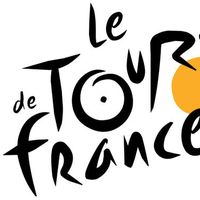
Tour de France
Related articles.
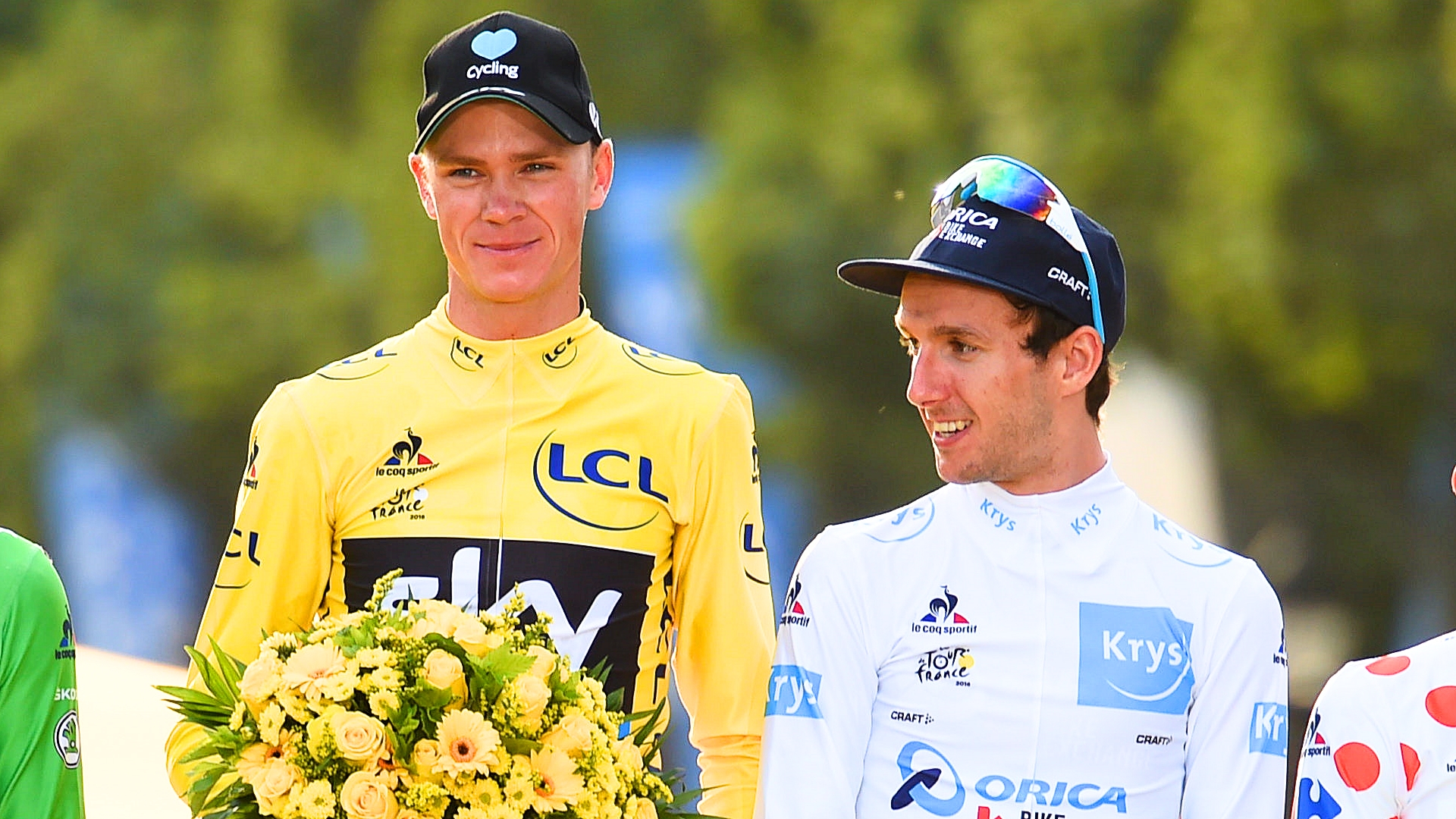
Comment: Rule Britannia at the 'Tour d’Anglais'
Phenomenal British success at cycling's greatest race shows no signs of slowing
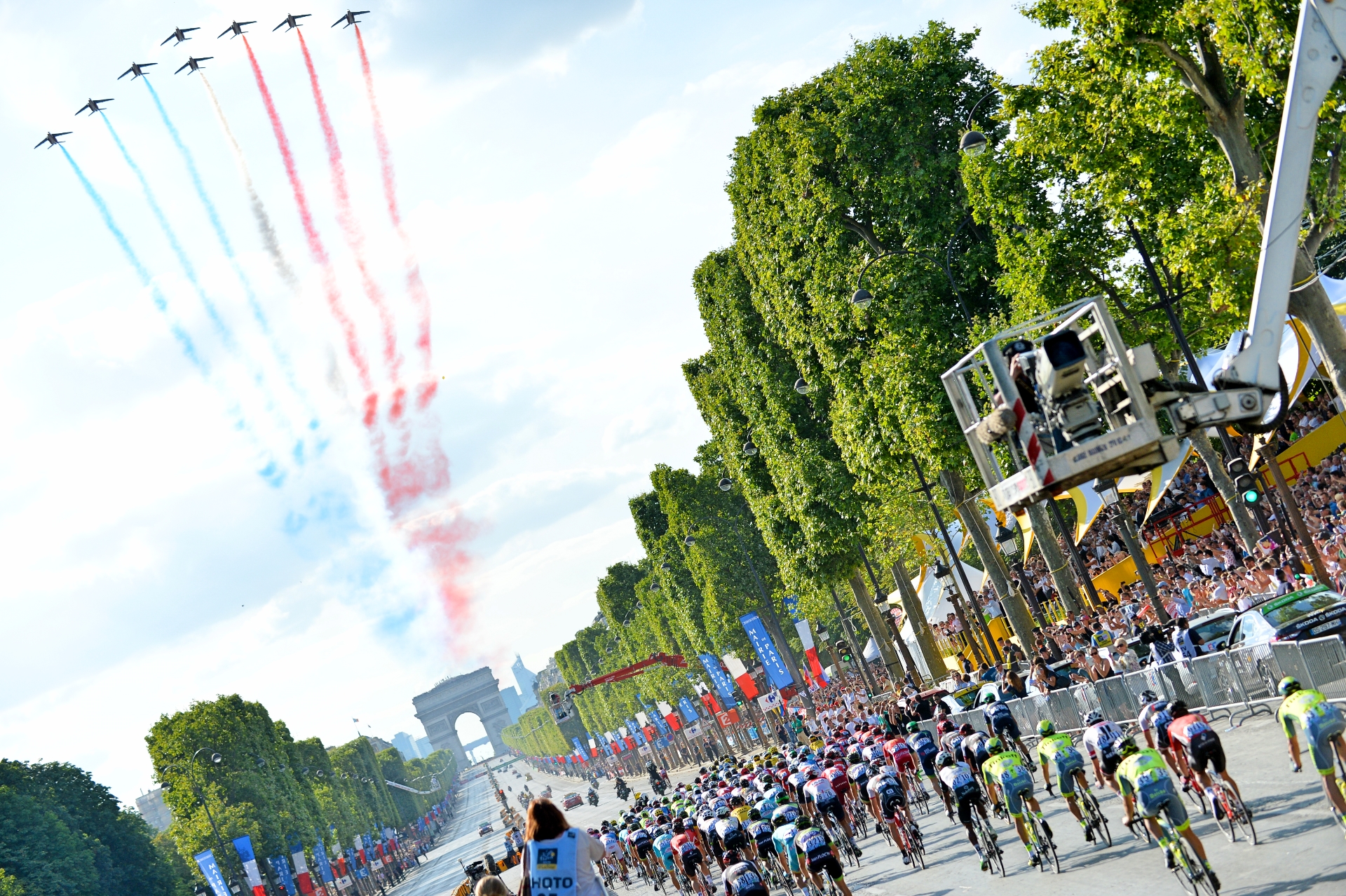
Which team left the Tour de France with the most prize money?
Chris Froome's overall victory helps Team Sky to €599,240 in prize money
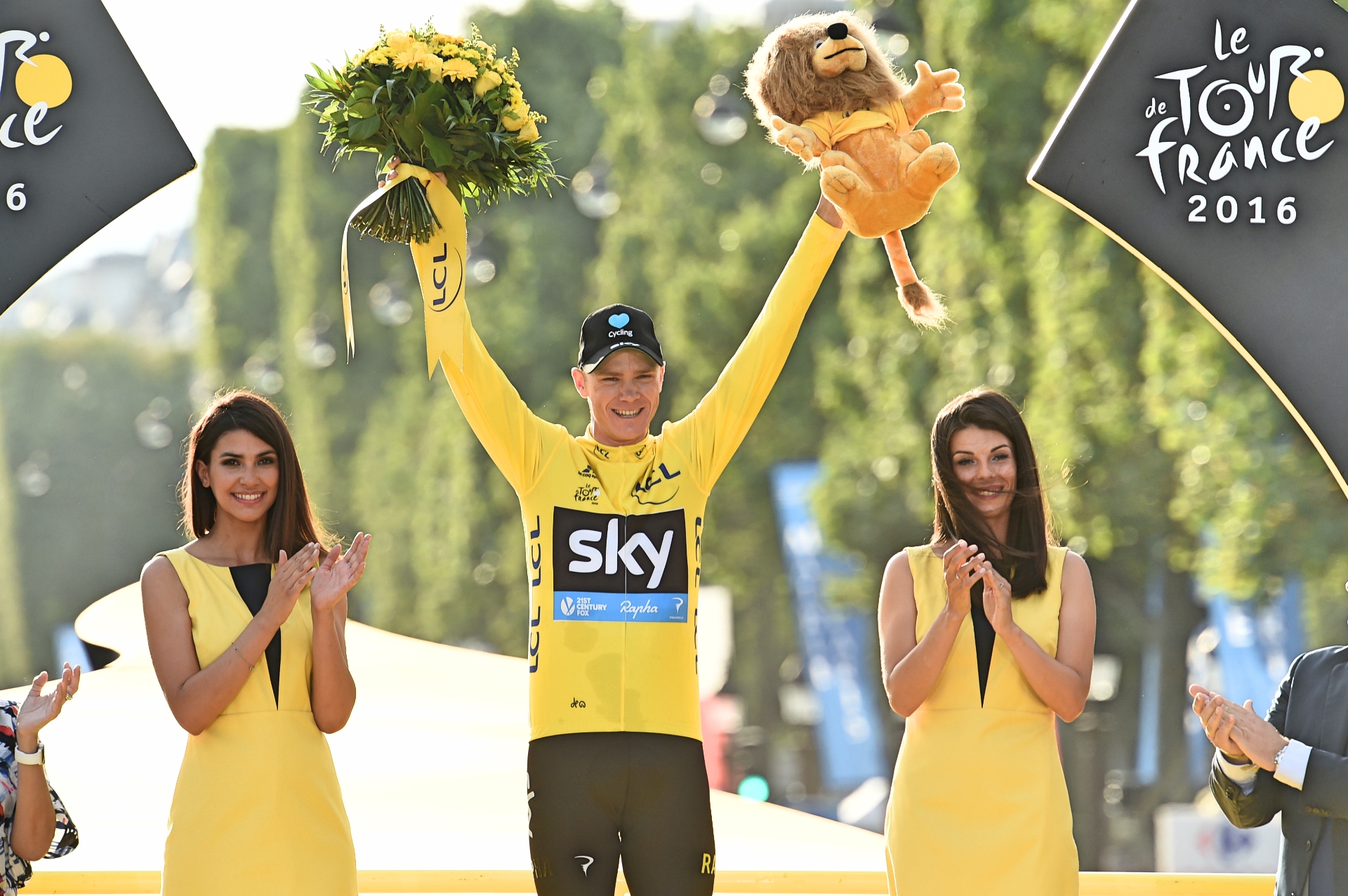
How Chris Froome won the 2016 Tour de France
Explosive descending, surprise attacks, relentless climbing and time trial success lead to yellow jersey
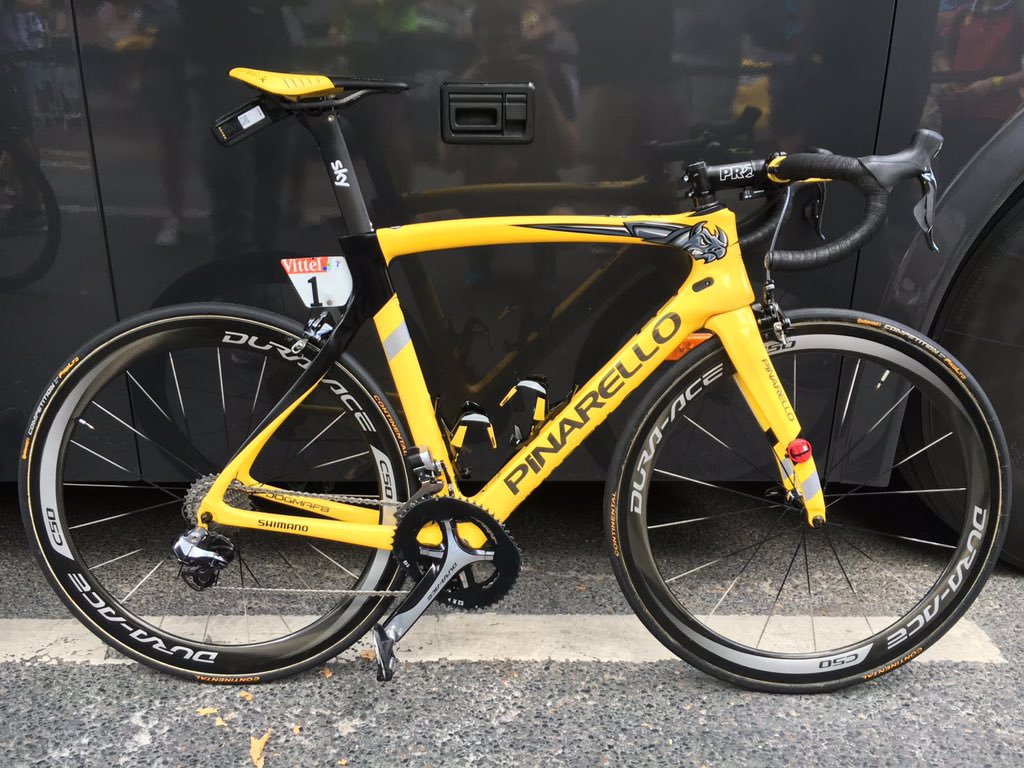
Photo gallery: custom bikes for Froome, Sagan and Majka on final stage of Tour de France
Yellow, green and polka dot bikes for the Tour de France jersey winners
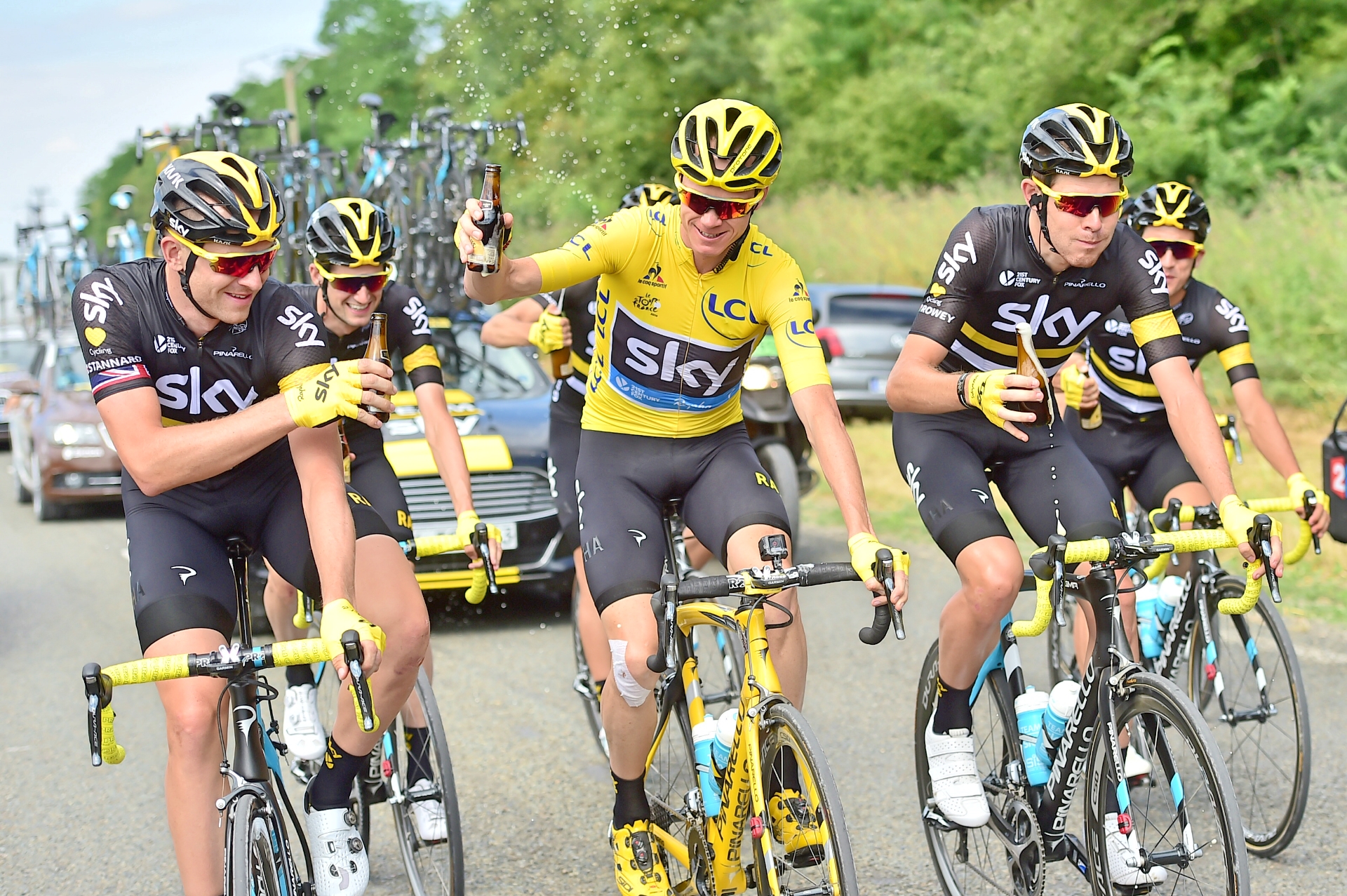

Tour de France 2016: stage 21 - photo gallery
Chris Froome celebrates third Tour de France win on the Champs-Elysees
Newsletter Terms & Conditions
Please enter your email so we can keep you updated with news, features and the latest offers. If you are not interested you can unsubscribe at any time. We will never sell your data and you'll only get messages from us and our partners whose products and services we think you'll enjoy.
Read our full Privacy Policy as well as Terms & Conditions .
Cookies help us deliver our services. By using this website, you agree to our use of cookies. Learn More
Tour de France: Crashed Froome forced to run up Mont Ventoux
Horde of fans swarm Froome, Porte and Mollema on decisive climb
Chris Froome ( Team Sky ) was forced to abandon his bike and run towards the finish at the end of stage 12 of the Tour de France to Chalet Reynard after the stage turned to chaos in the final kilometre.
Tour de France: Froome knocked from bike on Mont Ventoux, keeps yellow
- Tour de France stage 12 - Finish line quotes
Tour de France stage 12 highlights - Video
Tour de France: The unpredictable Mont Ventoux
Pandemonium in Provence: Tour de France crowds out of control on Ventoux
Froome: Mont Ventoux is full of surprises
Tour de France: Porte dismayed and angry with roadside spectators
Adam Yates: Froome is the rightful wearer of the yellow jersey
Tour de France: Lack of barriers in final kilometres of Ventoux stage due to wind, explains Prudhomme
Tour de France: Quintana content with where he stands after Ventoux
Froome, Richie Porte (BMC) and Bauke Mollema (Trek-Segafredo) had attacked together but then they rode into the back of a television motorbike that seemed to stop suddenly, possibly due to the road being blocked ahead by spectators. All three crashed and their rivals managed to ride past them.
Mollema got going quickly but Froome needed a new bike.
In the panic, he began to run up the road, sensing that the finish was not far away. He soon stopped and called his team on the radio. However, the Team Sky car was blocked in the chaos and so Froome took a spare bike from the Mavic neutral service. Yet even that failed to help him. It was not the right size and Froome had problem.
He eventually got a team bike and raced to the line trying to limit his losses. However, he finished close to two minutes back, shaking his head as he crossed the line.
"What a final. In the final kilometre, the moto braked suddenly in front of us, and Richie, Bauke and I crashed into it, and then the moto behind me ran over my bike and broke it," Froome said. "I said to myself 'I have no bike'. And I knew the car with my bike was 5 minutes behind on the road, so I need to run."
Get The Leadout Newsletter
The latest race content, interviews, features, reviews and expert buying guides, direct to your inbox!
- Tour de France: Froome knocked from bike on Mont Ventoux, keeps yellow
Due to his time loss, Froome was initially shown as slipping to sixth in the overall classification, 53 seconds down on Adam Yates (Orica-BikeExchange). However, officials revised the results, gave Froome and Porte the same finishing time as Mollema, meaning Froome kept his yellow jersey. He is now 47 seconds ahead of Yates and 56 seconds ahead of Mollema. Nairo Quintana (Movistar) who was in a chase group behind, is fifth at 1:01.
"I'm very happy with the commissaires' decision. I think it was correct so thank you to them," Froome said.
Team Sky's director Nicolas Portal weighed in on the situation saying, "There was no room for the motos or the riders to pass with the crowds. Chris' bike was broken in the crash and now we're waiting to see if commissaires decide to do something. I was blocked by the commissaires so I was behind Geraint Thomas when the incident happened. We were too far back. Everybody was blocked, including the Mavic neutral service car. It was a nightmare.”
Yates sportingly admitted that he didn't want to take yellow as a consequence of the chaos and Froome's time loss.
"I wouldn’t really want to take the yellow jersey like that, so I’m happy with the decision," he said.
"If I was in Froome’s position and I’d lost the jersey like that, I’d have wanted the same decision as him. It was pretty dangerous in the last kilometre but the fans make the sport and there’s not many sports where fans can get so close to the athletes. It is what it is. I wouldn’t have wanted to take the jersey like that. Froome is the rightful owner of the yellow jersey."
Media type: Twitter Media src: https://twitter.com/Vanlooyalfas/status/753608753245814786 Media caption: The moment of the crash
. @ChrisFroome à pieds dans le final de l'étape / @ChrisFroome is running in le Ventoux #TDF2016 https://t.co/o3fgyrRRST
Video Highlights

Thank you for reading 5 articles in the past 30 days*
Join now for unlimited access
Enjoy your first month for just £1 / $1 / €1
*Read any 5 articles for free in each 30-day period, this automatically resets
After your trial you will be billed £4.99 $7.99 €5.99 per month, cancel anytime. Or sign up for one year for just £49 $79 €59

Try your first month for just £1 / $1 / €1

Stephen is the most experienced member of the Cyclingnews team, having reported on professional cycling since 1994. He has been Head of News at Cyclingnews since 2022, before which he held the position of European editor since 2012 and previously worked for Reuters , Shift Active Media , and CyclingWeekly , among other publications.
Gaia Realini in La Vuelta Femenina lead after team time trial amid tight gaps
Arnaud De Lie kicks suspected Lyme disease, wins first race back
RideLondon Classique past winners
Most Popular
- Rugby union
Chris Froome forced to run up mountain in stage 12 of Tour de France – video
Chris Froome has held on to the yellow jersey at the Tour de France after stage 12 on Mont Ventoux ended in farce on Thursday. The defending champion was forced to run part of the end of the race after a collision involving Richie Porte and a motorbike left him without a bicycle. A jury’s decision led to Froome maintaining his hold on the lead
Stefania Orlando theguardian.com, Source: Tour de France
Thu 14 Jul 2016 19.04 BST Last modified on Wed 21 Feb 2018 17.47 GMT
- Share on Facebook
- Share on Twitter
- Share via Email
- Chris Froome
- Tour de France
- Tour de France 2016
Most popular
The history of the Tour de France

Volume 5 - Targeted Topic - Sports Medicine in Cycling

– Written by Will Fotheringham, United Kingdom
Most memorable sports events come down to a single image of a single instant, transmitted around the world and distinctive enough to stick in the minds of fans and the media. The 2016 Tour de France produced the sight of the lanky, raw-boned Briton Chris Froome running towards the top of a mountain, having thrown his broken bike to one side. That would have been surprising enough, but the fact that Froome was wearing the fabled yellow race leader’s jersey and that he went on to win the 2000-mile 22-day marathon made it one of the sporting moments of the year.
It was less than a minute before Froome was given a replacement bike, but still, the brief episode summed up why the Tour de France has gripped the imagination since it was founded in 1903. In the pioneering years, the cyclists had to take to their feet on a regular basis: there were mountain climbs they couldn’t pedal up and there were occasions when they had to wheel a broken bike for miles to find a place for repairs.
The peripherals – the level of support received by the cyclists, the quality of their bikes and kit – have changed over the years, but the common chord between the men who pedal and the public who watch them remains the same after 113 years: you give everything in your power to get to the top of the hill. When the Tour was launched, the link was a fundamental one, everyone in rural France rode a bike to get to work so they knew just how much physical exertion was required to get from A to B.
Nowadays, the crowds who throng the roadsides for the Tour’s 20 stages of roughly 100 miles each are a mix of cyclists from outside France, and locals estimated at between 12 and 15 million, the biggest for any sports event worldwide. Tour fans don’t get to see the event unfolding in front of them from beginning to end as happens in a stadium environment.
The race itself can pass in as little as 30 seconds if the 200 cyclists are all together, offering at most a snapshot of a whole day’s racing action. But it offers a spectacle which is free to view and, because of the scale of the caravan of vehicles that accompanies the Tour, the entire show takes several hours from beginning to end, although for many less committed fans, the big draw is a caravan of publicity vehicles chucking out free samples.
While for locals this is a national institution, hardcore cycling fans can ride their bikes over precisely the same roads as the race itself uses, before or after the event – the two-wheeled equivalent of bowling a cheeky over at Lords or taking a jump at Aintree. For a sports event of this magnitude, in the 21st century, the Tour is astonishingly accessible. By and large, there are no barriers – apart from close to the finish or through towns – so the race passes inches from the spectators; as riders toil up the mountains, it is easy to make out precisely who is who.
The interaction between fans and stars is unmatched. Fans hand drinks to the riders – Belgium this year mourned the death of an aficionado, Lucien Blyau, who had served up hundreds of mini cans of Coke to the Tour riders each year for 35 years – and on occasion help out when riders have mechanical issues. Struggling backmarkers are pushed up mountains. The fans dress up for the television cameras and run alongside their heroes even as the key moments of the race unfold.
Which brings us back to the Froome incident, on Mont Ventoux in Southern France on July 14, Bastille Day. The Tour leader broke his bike when he collided with a motorbike conveying a cameraman, which had been held up when the crowds spread too thickly onto the road. As he ran up the mountain – knowing that, bike or no bike, every yard closer to the finish line would reduce the time he lost – some of the crowd ran with him, others shot video of the episode on their mobile phones. The mix of mayhem and sporting endeavour was typical of the Tour, which has blended excess and heroism in equal measure since 1903.
The Tour was launched as a publicity stunt during a circulation war between two sports papers: the well-established Le Vélo and its upstart rival, l’Auto , which covered a range of sports in spite of its title. Cycle races had developed rapidly in the late 19th century once the pastime became popular, but most were standalone, place-to-place affairs; Le Vélo was the market leader among the papers that reported the sport and organised the two biggest races: Paris-Brest-Paris and Bordeaux-Paris. The struggling l’Auto needed a sensational idea to boost its sales, running at about a quarter of Le Vélo’s 80,000 and it was its chief cycling reporter, Géo Lefèvre who came up with the idea of a race around France in six stages: Paris-Lyon-Marseille-Toulouse-Bordeaux-Nantes-Paris.
Initially, there were doubts whether any of the 60 starters would manage to complete the marathon stages of the first edition, even though there were 13 rest days interspersed between the stages, but the race was a popular success. The second edition was a disaster, however, with riots along the way as crowds attempted to influence the outcome in favour of their local heroes; the first four finishers overall were disqualified, including the winner of the first year’s race, the extravagantly moustachioed Maurice Garin.
The verdict of l’Auto’s editor Henri Desgrange after the Tour of 1904, was that the race was “dead”, but in fact he and Lefèvre had created a unique event, a picaresque soap opera, an early 21st century version of a reality television show in which the cast of characters – heroes, villains, likeable losers, charismatic charlatans – struggled and fought against a constantly changing backdrop. Their daily doings were catnip for the readership and sales rocketed to 65,000; eventually, Le Vélo would close, while the direct descendant of l’Auto – l’Equipe is still France’s leading sports newspaper.
The first turning point came in 1910, when Lefèvre and Desgrange routed the race through the Pyrenees. The route was reconnoitred in winter, when the passes were blanketed in snow so deep that the roads could not be made out; that summer there were fears that the riders might be attacked by bears. The pair weren’t certain that any of their men would make it over the dirt tracks of the Col de l’Aubisque and Tourmalet. Desgrange was so nervous he didn’t dare attend the stage. The riders had to push their bikes and as the eventual race winner Octave Lapize passed Lefèvre, he muttered: “you are all murderers.”
Desgrange’s response was to make the race even harder, by taking the race into the Alps the following year, when it crossed the 2645 m high Col du Galibier and also by lengthening the distance to well over 3000 miles, while tightening the rules to the point where the Tour seemed positively at odds with the men who competed in it. Racing at night was abandoned to make the riders less vulnerable to wayward fans, while the stages were shortened and increased in number, so that the event expanded to last 3 weeks. That of course meant more sales.
Broken bikes were common in the early days; as late as 1928 one rider rode 55 miles on a ladies’ bike borrowed from a spectator, while the ‘Old Gaul’ Eugène Christophe broke his forks in 1913 as he descended the Tourmalet pass, ran eight miles to the town at the foot of the mountain to find a blacksmith’s forge and laboriously made a new set from plain metal tubes. That took him 4 hours, with the race organisers watching all the while to ensure he received no outside assistance. At one point he let a small boy work the bellows, for which he was given a time penalty. In the 1920s, riders could be penalised for infractions as trivial as wearing the wrong jersey or not showing a broken bike to the organisers.
Christophe is immortalised with a plaque on a wall on the site of the blacksmith’s in Saint-Marie de Campan; he is also celebrated as the first rider to wear the yellow race leader’s jersey. The maillot jaune is now one of sport’s most coveted prizes, but in 1919, when Desgrange brought it in, it was merely a way of enabling spectators to spot the rider who was leading the event. By happy coincidence yellow was also the colour of the paper on which l’Auto was printed, although it is also said that yellow was the cheapest colour the jersey makers had in stock. In any case, the maillot jaune gave the race a daily focus: who was leading, who might lead, who had led.
The event that guaranteed the Tour’s success into the 21st century came in 1936, when paid holidays were instituted by law in France. Desgrange had given his race a July date; the bulk of the population took their time off in summer, giving the Tour a ready-made audience in search of innocent diversion. That meant a trip to watch the race became as integral to the French summer as a trip to the sea, if not more so given the geography of France. By then, they had the publicity caravan to watch; the parade of advertising floats preceding the actual race was instituted in 1930, purely as a way of boosting its income.
The Tour was suspended during both World Wars and it enjoyed a golden age in the years after World War II, when home riders such as Louison Bobet and Jacques Anquetil won time after time – three times in Bobet’s case, five for Anquetil, whose rivalry with Raymond Poulidor is deeply etched into French consciousness to this day. Until 1961 the race was contested by national teams, with France fielding both a national squad and various regional outfits; that led to intense focus on who would lead Les Bleus and who would ride in which team, all adding to the immense hype around the event.
The proliferation of French stars, national and regional, spawned a whole range of local races, track meetings and circuit events around towns throughout France in which the heroes of the Tour would be on view. Until the 1990s, most of a professional cyclist’s income came not from prize money or a team retainer, but from appearance fees directly related to how he had fared in the great race.
There were small steps forward – notably in 1975, when the Tour finished on the Champs Elysees for the first time – the big change came in the 1980s when the Tour went global. The Italians, Spanish and Belgians had been present almost from day one, with Spain and Italy eventually acquiring their own three-week Tours to rival France’s. The British had appeared in the 1950s, when memories of the Liberation were still strong – the first Briton truly to break through at the Tour, Tom Simpson, was not nicknamed 'Tommy' by chance. The 1980s saw the arrival of Americans, Australians, Colombians and East Europeans, with the Russians following in 1990.
In 1990, a third victory for the American Greg LeMond cemented the Tour’s status as a sports event of world stature. The expansion was massive, with the arrival of major sponsors such as Coca-Cola, which famously displaced Perrier water as the race’s official drink (today it is Vittel). Starts outside France became more common – Berlin in 1987, Dublin in 1998, London in 2007 – and the Tour travelled outside its borders more frequently, although plans for a start on America’s east coast never bore fruit.
As the 21st century beckoned, scandal hit the Tour, with the 1998 race coming close to being abandoned after police raids came across industrial quantities of banned drugs. The seven successive victories for the American cancer survivor Lance Armstrong expanded the global audience further, but the Texan’s wins have been blanked from the record books after he was revealed to have been using banned drugs such as the blood booster erythropoietin and blood transfusions. Armstrong was far from the sole offender – the 2006 winner Floyd Landis and the 2010 victor Alberto Contador were also banned for doping and their victories expunged – and questions continue to be asked of his successors.
Desgrange’s event hinged on the creation of heroes managing feats that were ever more superhuman, but since the 1980s the race has been gradually pared back in distance. Once the norm, stages over 200 kilometres are now the exception; on the other hand, there are now more mountain stages than ever before as the organisers seek to make the race more dynamic and spectacular – both scenically and competitively – with the worldwide television audience specifically in mind.
When Chris Froome won the 2016 race he joined just a handful of men to win the race three times, the first being the Belgian Philippe Thys, nicknamed ‘The Basset Hound’, whose victories came before and after the First World War. The second was the Brylcreemed picture book hero Louison Bobet, who began life in a bakery in Brittany and ended it a successful businessman on the back of his Tour hat-trick in 1953 to 55. His era came just after the heyday of the Italians, when the mournful looking Fausto Coppi managed – in 1949 and 1952 – the double with his home Tour, the Giro d’Italia, a feat which remains rare to this day.
Coppi and Bobet were the two biggest characters in the Tour’s golden era, which was populated by charismatic stars such as Coppi’s great rival Gino Bartali, a famously religous man who built a chapel in his house and worked to save refugees from the Nazis during World War II and the Spaniard Federico Bahamontes, the Tour’s greatest ever mountain climber, famed for an episode in which he escaped up a mountain pass and paused at the summit to eat an ice cream.
Anquetil was the next great star, although his five Tour wins between 1957 and 1964 could not earn him the popularity of his great rival Raymond Poulidor, who never even wore the yellow jersey, yet remains one of France’s most popular sportsmen by virtue of his innocent smile and bashful demeanour. Anquetil was criticised for his clinical racing style and aristocratic hauteur, but harsher words came the way of the next Tour great, Eddy Merckx, who dominated the entire sport, year-round, from 1968 to 1976, taking five Tours along the way in just six starts. Merckx would win up to eight stages per Tour – a third of what was on offer – and would take most of the subsidiary prizes as well; he received virulent hate mail from French fans because he appeared so invulnerable and did not become truly popular until 1975, when he completed the Tour in a valiant second place after breaking a cheekbone in a crash and surviving on liquid food.
Merckx was an aberration in an era of French dominance of the Tour; his last win in 1974 was followed by nine French victories in 11 years, five of them going to the pugnacious Breton Bernard Hinault, who led a riders’ strike in his first Tour, 1978 and fought memorably against LeMond – his own team mate – as the American took his first win in 1986. LeMond’s second win in 1989, against the Frenchman Laurent Fignon, remains the Tour by which all others are judged and mostly found wanting. Neither of the pair were at their best, which meant one would take the maillot jaune before losing it to the other, but never by more than a small margin. The 1989 race culminated in a time trial stage finishing on the Champs Elysees, with LeMond snatching the race win by a mere 8 seconds. That LeMond had returned from a shooting accident, which came close to costing him his life and which had left him with lead shot throughout his body, merely added to the romance.
It is said that, until l’Auto began publishing maps to illustrate the Tour route, few French people actually had an idea of what their country looked like on paper. Thanks in part to the epic rivalry between Poulidor and Anquetil, the Tour has put down firm roots in French culture and politics, even though, for many years, cycling was looked down on as a working-class, blue-collar sport. This holds now, even though no Frenchman has actually won the Tour since 1985.
The critic Roland Barthes included a section on the race in Mythologies, his 1957 exploration of how we imbue certain events and people with epic qualities; Froome’s brief run this year took place on Mont Ventoux, the mountain which Barthes calls the most evil of all the Tour’s ascents and added another twist to the mountain’s mythology. The Tour has been immortalised by rock groups – most notably Kraftwerk, by film directors such as Louis Malle and Claude Lelouch, and in animations such as Les Triplettes de Belleville (a.k.a. Belleville Rendezvous).
It has been appropriated by politicians such as Jacques Chirac and Nicolas Sarkozy; before becoming president, Francois Miterrand described himself as, “the Poulidor of Politics”. It was Chirac who brought the Tour to the Champs Elysees when he was the mayor of Paris – the only other day in the year when the great avenue is closed is Bastille Day, for the Military Parade. After the Second World War, the Tour’s revival was a symbol of the country’s return to normality and in 1968, amidst student riots, the Tour went ahead as a signal that France was functioning as usual.
The 2016 edition was run amidst tight security in the aftermath of the Paris attacks of November 2015, an atmosphere of tension heightened after the Bastille Day carnage in Nice. A day later, as the race skirted Lyon, the rural roads were packed with crowds waving tricolours while heavily armed police maintained a discreet presence. There were few banners and no overt political statements, merely the feeling that here was a vast, silent mass of people proclaiming their faith in the centrepiece of the French summer.
Will Fotheringham
Cycling Correspondent
The Guardian
London, United Kingdom
Further reading
- Fotheringham W. Roule Britannia, Great Britain and the Tour de France. London, United Kingdom: Yellow Jersey Press 2012.
- Wheatcroft G. Le Tour: A History of the Tour de France. London, United Kingdom: Simon and Schuster 2013.
- Nicholson G. The Great Bike Race. Oxford, United Kingdom: Velodrome Publishing 2016.
Image by Brian Townsley
Practical considerations for endurance training with power
Surgical management of upper limb injuries in cyclists, more from aspetar journal.
Written by – Richard Knight, Len Funk, Adam Watts and Mike Hayton, United Kingdom
Practical recommendations for endurance cycling in hot/humid environments
Written by – Dave Nichols, Qatar
Doping and anti-doping in cycling
Written by – Yorck Olaf Schumacher, Qatar
Latest Issue
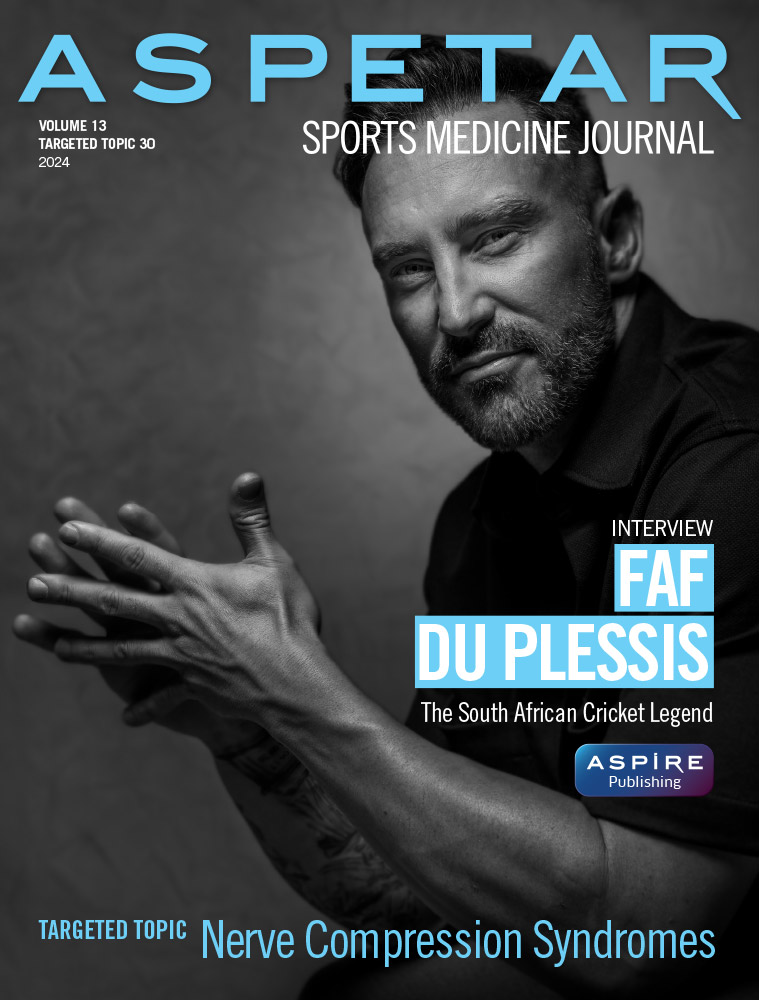
- Sports Science 98
- Sports Medicine 141
- Sports Surgery 71
- Sports Rehab 64
- Sports Radiology 33
- Sports Pharmacy 9
- Sport and Society 21
- Healthy Lifestyle 30
- Letters From 31
- Interview 49
- Legacy of Arabic Medicine 15
- Editorial 51
Organization members

IMAGES
COMMENTS
July 14, 2016. VAISON-LA-ROMAINE, France — His bike crushed under a motorcycle's tires, his Tour de France lead in jeopardy and his rivals pedaling away, Chris Froome did the only thing he ...
CHRIS FROOME WINS THE 2016 TOUR DE FRANCE! ... Froome has run up mountains, bled through his yellow jersey, borrowed bikes and gone for broke to squeeze every second out of the road to Paris ...
The downhill attack. A small gain from an unusual descending technique helped Chris Froome win stage 8 of the 2016 Tour de France. Everyone expected Froome to make an attack when the race hit the ...
Chris Froome forced to run up mountain in stage 12 of Tour de France Guardian Niall McVeigh Thu 14 Jul 2016 12.16 EDT First published on Thu 14 Jul 2016 06.00 EDT
CNN —. Chris Froome secured a third Tour de France title Sunday after crossing the finish line in Paris alongside the Team Sky teammates who have helped propel him to victory. The British rider ...
Chris Froome (Team Sky) elevated himself further among the cycling greats by winning the 2016 Tour de France in Paris on Sunday, his third Tour victory. Froome took the lead after winning stage ...
Jon Izaguirre won the final mountain stage of the Tour de France to Morzine on Saturday but Chris Froome maintained a strong lead of over four minutes going into Sunday's final stage
— Le Tour de France (@LeTour) July 14, 2016 The stage ended with controversy, as Froome fell to sixth in the time standings while a race jury decided how to handle the mess. Its decision:
14th July 2016. Sponsored by. Chris Froome remains the leader of the 2016 Tour de France after a commissaire ruling, despite having to run part the way up Mont Ventoux after a crash involving a TV ...
Still in the #YellowJersey #TDF. — Chris Froome (@chrisfroome) July 14, 2016. So while waiting for his team to bring a new bike, Froome ran up Mont Ventoux's steep incline, before hopping on a ...
Chris Froome was involved in a bizarre accident during stage 12 of the Tour de France that led to the yellow jersey wearer running up Mont Ventoux.. The accident was triggered by Froome's former ...
Chris Froome ( Team Sky) was forced to abandon his bike and run towards the finish at the end of stage 12 of the Tour de France to Chalet Reynard after the stage turned to chaos in the final ...
Chris Froome had to run over the finish line after a cyclist pile-up on the 12th stage of the Tour de France Thursday. Credit: APStephane Mantey/ Pool Photo via AP. Chris Froome had to literally ...
A jury's decision led to Froome maintaining his hold on the lead Stefania Orlando theguardian.com, Source: Tour de France Thu 14 Jul 2016 14.04 EDT Last modified on Wed 21 Feb 2018 12.47 EST
Not often seen on the Tour de France : 💛 the Yellow Jersey wearer Chris Froome with his feet on the ground up Mont Ventoux 🏃
Revivez la 12e étape du Tour de France 2016 qui s' est déroulée le jeudi 14 juillet 2016 entre Montpellier et le Chalet Reynard sur une distance de 178 kilo...
The 2016 Tour de France produced the sight of the lanky, raw-boned Briton Chris Froome running towards the top of a mountain, having thrown his broken bike to one side. That would have been surprising enough, but the fact that Froome was wearing the fabled yellow race leader's jersey and that he went on to win the 2000-mile 22-day marathon ...